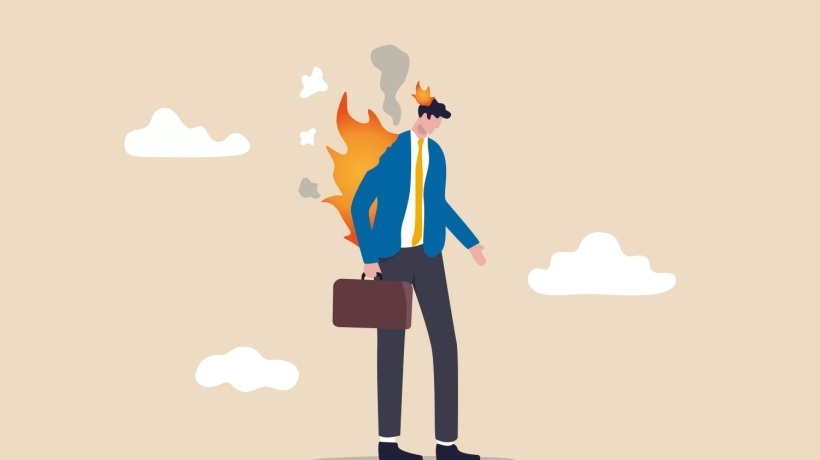Take Control Of Employee Well-Being Now
Professional burnout may not be a new phenomenon but the term itself is. The idea of “burnout” was first coined in the early seventies by Herbert Freudenberger in his book Burnout: The High Cost of High Achievement. In his book, he defines it as “the extinction of motivation or incentive, especially where one's devotion to a cause or relationship fails to produce the desired results.”
3 Components Of Burnout
According to psychologist Christina Maslach, burnout is characterized by 3 main components: exhaustion, cynicism, and inefficacy.
1. Exhaustion
Exhaustion is a mixture of physical, cognitive, and emotional fatigue that comes from “running on empty” for too long. In an organization, this exhaustion usually stems from a 24/7 work culture, having an excessive workload or unrealistic deadlines, or not having the necessary skills, training, or resources to carry out your work. This type of exhaustion runs deep and “a good night’s sleep” or a two-week holiday simply isn't enough. Changes at a job, on a team, or on an organizational level are needed.
Put simply, if you feel exhausted, you start to dread going to work and your motivation and performance drop, you just might be showing signs of professional burnout.
The average person spends 30% of their life working. Feeling exhausted, overstressed, overwhelmed, or numb for a prolonged period of time can and, most likely, will have a huge negative impact on your life and general well-being, not to mention those around you such as family, friends, and colleagues.
2. Cynicism
Cynicism is another key component of burnout. Cynicism can also be described as depersonalization, demotivation, or a loss of engagement. Burnout can cause sufferers to mentally distance themselves from their work environment and to detach from projects, colleagues, clients, and the company culture. It can also lead to negative feelings towards their job, colleagues, and workplace in general, which can have a detrimental impact on the wider team and organization. Signs of cynicism might be a lack of participation, speaking unfavorably about other colleagues or your employer, or no longer taking pride in your work.
3. Inefficacy
The third component of burnout is inefficacy or feeling incompetent and unproductive. While we are all well-versed in emotional well-being, sometimes it’s easy to forget about purposeful well-being. As humans, we crave the feeling that we are achieving, producing, learning, and that the work we are doing has a purpose. That feeling of purpose and value plays a huge role in our emotional well-being.
When people feel burnt out, they might worry that they aren’t accomplishing what they should be and can begin to feel demotivated and frustrated. This can often happen in a workplace where there is a lack of resources and support to perform well, an absence of feedback, no meaningful recognition, or an unclear performance management program to let workers know how they’re doing and address performance blockers.
It’s often said that people don’t burn out because they’re working too hard, but rather because they’re working on things that don’t bring them joy. There’s a big difference.
Signs Of Employee Burnout
While burnout isn’t currently a diagnosable disorder, it is a serious issue that needs to be treated as such. Studies have found a link between burnout and other negative physical and mental health issues such as depression and anxiety, high blood pressure, cardiac issues, sleep disturbances, and increased use of drugs and alcohol. On top of this, sufferers of burnout often report feeling alienated and an overall negative impact on their relationships and career prospects.
Before we address how organizations can help to prevent burnout, the first step is to learn to recognize the signs of burnout in yourself or in your team.
Isolation And Alienation
People suffering from burnout often experience alienation from work-related activities because they feel so stressed and overwhelmed that they feel the need to disengage from their work life and colleagues as much as possible as a coping mechanism.
Physical Symptoms
Burnout is essentially chronic stress, and we’re already aware of the physical symptoms that can come with high-stress lifestyles. If you’re experiencing burnout, you may develop headaches, stomach issues, sleep disturbances, and increased susceptibility to illnesses like colds, flu, and infections.
Feeling Emotionally Drained
Experiencing burnout can take a serious toll on your emotional well-being. You may feel drained, overly cynical or negative, and tired even after a good rest. Burnout can also lead to mood swings or feeling more emotional or sensitive than usual.
A Drop In Performance
Burnout can make performing everyday tasks a challenge. You might notice that you lack motivation, your creativity is reduced, you have difficulty concentrating, and you are not performing to your usual standards.
Memory Loss
Those suffering from anxiety or a high-stress environment may even experience some mild memory loss. As they are stuck in a thinking loop, they tend to forget about other tasks, events, or conversations.
The 5 Stages Of Employee Burnout
Burnout is a result of long-term stress and feelings of being overwhelmed. According to LinkedIn’s Glint platform, there has been a 33% jump in burnout in the past two years. While it can affect people at any stage, research shows that the average age a professional experiences burnout is 32.
Aside from the telltale symptoms mentioned above, there are some other ways to recognize early signs of burnout. According to Winona State University, there are 5 stages of burnout. Understanding the stages could help to diagnose burnout early and prevent reaching the final stage of habitual burnout.
1. The Honeymoon Phase
When we start a new job, task, or project, we usually start off feeling motivated, productive, creative, energetic, and enthusiastic. In the first stage of burnout, you might start to notice an increase in stress levels related to this new role or task which is perfectly normal when starting something new. It’s at this stage where some good coping strategies and mindfulness exercises could prevent burnout.
2.The Onset Of Stress
In the second stage of burnout, you may start to notice some common signs of stress and a loss of some of that initial enthusiasm and positivity. Some telltale signs include irritability, avoiding making decisions, reduced productivity, forgetfulness, problems sleeping, anxiety, headaches, teeth grinding, and changes in appetite.
3. Chronic Stress
The third stage of burnout is chronic stress. At this stage, your stress levels are very high and you might experience more heightened symptoms such as procrastination, missing deadlines, panic, constant fatigue in the mornings, physical illness, mood swings, apathy, a cynical attitude, an increase in drug and alcohol consumption or other escapist activities, and withdrawing from social situations.
4. Burnout
Stage four is burnout itself. When you reach this stage, your situation is serious, and continuing as normal is often not possible. You may find yourself feeling empty, pessimistic, suffering from physical ailments such as chronic headaches, stomach issues, and higher susceptibility to illness, social isolation, behavioral changes, and being stuck in a negative thought loop.
5. Habitual Burnout
The final stage of burnout is habitual burnout. At this stage, the symptoms of burnout are now a constant in your life. You may notice that you suffer from depression and chronic mental and physical fatigue. When burnout reaches this level, sufferers will often need to seek the advice of a medical professional and may even require a leave of absence to recover.
Burnout doesn’t have to reach the critical stage. When the signs are recognized early and self-care practices and organizational changes are applied, it’s possible to bounce back.
Help Prevent Burnout On Your Team
Managing a team means managing your team’s well-being. There are plenty of ways that organizations can help employees prevent and manage burnout. Recognizing the signs and taking action immediately is key. It’s also important to remember that burnout is less likely to be an individual issue. If one person in your organization is suffering from burnout, it’s likely to be a wider issue.
The signs of burnout can be obvious in some people and barely detectable in others. Keep an eye out for tiredness, lack of focus, depressed mood, hostility, and signs of being overwhelmed. Regular check-ins are essential when it comes to spotting early signs. Make them part of your team culture, even during your busiest periods.
Here are some actionable steps organizations can take to keep burnout at bay:
Set Limits On Workloads
The first step is always to get to know your team’s workload. When there’s total transparency in the team with regard to workload and capacity, it allows you to collectively make sure that assignments and deadlines.
Insist On Breaks And Boundaries
Organizations and managers can help prevent burnout by reiterating how important resting and recharging are. This starts with boundary setting. Encourage employees to set limits on working hours and follow up to make sure they’re sticking to their boundaries.
Recharging your batteries before they get too low is another surefire way to avoid burnout. This is exactly why organizations should be encouraging (or even obliging) employees to use their annual leave.
Lead By Example
The best way to affect behavioral changes in an organization is to lead by example. This means that employees at all levels should take their full vacation time, respect bank holidays, and set reasonable working hours. Whether it’s intentional or not, when employees see people leaders working late nights and not taking their annual leave, they think this is the company culture and follow suit. Changing culture and behaviors starts at the top and trickles down.
Clarify The "What," "Why," And "How"
One of the biggest causes of stress in the workplace is unclear leadership. When you don’t know what you’re supposed to be doing or why you have to do something a certain way, this often turns to frustration. This is exactly why clarifying expectations is so important.
Let your colleagues know exactly what is expected, why it should be done a certain way, and how this approach will be beneficial. When possible, be flexible on where, when, and how employees get the work done. Micromanaging is toxic in a team.
Push For Extra Resources When Your Team Needs Them
If, in your regular check-in, you see signs that your team is struggling and needs more resources, fight for them. Get to know your team’s pain points or barriers, figure out what resources would be most effective, and push for the extra resources they need. You might not win every time, but just knowing that their manager is advocating for them and is aware of their struggles will do wonders for team morale.
Set Aside Uninterrupted Time For Your Team
Have you ever had a lot of important tasks to carry out but you just can’t find more than fifteen uninterrupted minutes to do them? This is a huge factor in burnout. When we’re up to our eyes in meetings, it doesn’t leave much focus time for those tasks that need our undivided attention.
Encourage your team to block out chunks in their calendar to give them time to complete these tasks. Communication is clear here so that if something urgent pops up, the team knows that they can schedule a meeting during that block. But only if it’s urgent. By allocating blocks of focus time, your team can get into the zone and concentrate fully on the task at hand. Not only is this great for productivity, but it gives employees a sense of achievement and alleviates pressure.
Develop A Culture Of Recognition And Praise
Developing a feedback culture can do wonders for employee engagement and morale. When we know we’re doing something well and that our hard work is recognized not only by our managers—but our colleagues too—we tend to feel more motivated and engaged.
The best way to create this culture is by making it a habit to recognize wins, no matter how small. Reward hard work and make sure that you publicly acknowledge how your team’s hard work has positively impacted the business.
Make Learning A Priority
Studies suggest that workers who are continuously learning are less likely to experience burnout. During one-to-ones and performance check-ins, find out what your team’s development goals are and what resources or training they need to achieve them.
When possible, allow employees to allocate time in their week to learn and share their learning with the team.
Pump Up Team Spirit
Workers who feel part of a team and who feel supported by their colleagues are much less likely to burn out. Invest time in making sure that your team is aligned. Give regular updates on the progress of team goals and look for opportunities for teams to collaborate and offer support. Where possible, cross-train your team so that there can be all hands on deck during hectic periods. It may also help people feel more comfortable taking their vacations, knowing there are more people to cover the workload.
Building community will lead to a happier, more productive, and inclusive team.
Empathy Rules
Encourage empathy in your team and set an example of how to treat each other with respect and compassion. One simple way to get your team to put themselves in their colleagues’ shoes is to encourage people to share what’s going on with them outside of work. It goes without saying that discretion is needed here and boundaries should be set, but it can be a great way to unify your team and build a sense of belonging.
What Organizations With Low Employee Burnout Rates Have In Common
In Glint’s research on burnout, they identify some of the possible causes for the increase in burnout in the past few years. One factor that seems to have contributed to burnout is the rapid increase of remote work.
It’s always been tough to separate work and personal life. We’re human after all. However, as we enter the era of remote and smart working, it’s even tougher to compartmentalize work and personal life. Glint believes that this is leading to an increase in burnout and that one way to counteract this is for people leaders to promote employee wellness and engagement. But how do great companies achieve this?
They Promote Well-Being
One of the best ways to combat burnout in your organization is to invest in well-being in the workplace and promote it. Give employees the tools they need to combat it. Empower your employees to take control of their well-being by providing training, resources, and initiatives that promote self-care, mental health education, and tips on how to spot the signs. The first step is always education.
When we talk about employee well-being, we’re not just talking about a coffee morning or exercise class. We need to dig a little deeper, starting with belonging. There was a 12% rise in the impact that belonging has on an employee’s sense of happiness at work.
Employees who share a strong sense of belonging typically have a shared sense of purpose (clear and aligned team and organization goals), they feel included and accepted by their team (a great diversity and inclusion program), and they feel cared for and offer care to their team (an excellent team culture).
They Encourage Employees To Change Their Outlook
While some well-needed R&R can curb the effects of burnout, we really need to get to the root cause. This usually calls for a shift in perspective. Unfortunately, for most of us, there will always be times where we face a huge workload, lack of resources, or workplace conflict. It’s a part of life that we simply can’t always control.
We can, however, control our perspective. Take time to look at what is causing your burnout. Are you exhausted? How can you prioritize your tasks? Are there any that can be delegated? Can you speak to your manager about reshifting your job role to give you more time to work on your more fulfilling tasks?
Are you feeling extra cynical? How can you remove yourself from that situation without disengaging from the organization as a whole? Could you shift your focus to other projects with people that you have more positive relationships? Do you feel unproductive? Why not look for development opportunities within the company? If it’s recognition that you’re missing, is there a way to ask for more feedback from a wider group? Take control and find someone who excels in personal branding and see what you can learn from them.
Essentially, we need to take stock of what parts of our job bring us joy and try to do as much of that as we can.
They Promote And Facilitate Building Connections
If you feel disengaged and disconnected, building your relationships with your colleagues is often the best cure. Seek out people in your company who energize and inspire you. Build a community that offers mutual support and holds each other accountable for its collective well-being.
This could be sharing playlists, giving each other feedback, or sharing interesting articles. Burnout is much less prevalent amongst workers with a strong support system.
Conclusion
Burnout can feel like it’s drowning you, or even changing who you are as a person. Even though it may feel like you can’t break free of it, you absolutely can. Get to know the symptoms and causes, look out for warning signs in yourself and your colleagues, and take action to turn it around. There is no shame in feeling overwhelmed. Opening up and sharing your experience with others can help you to realize that you’re not alone and, most definitely, it isn’t a life sentence.










